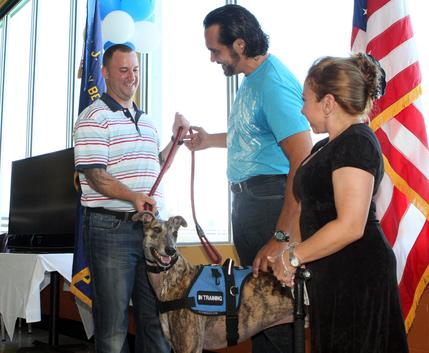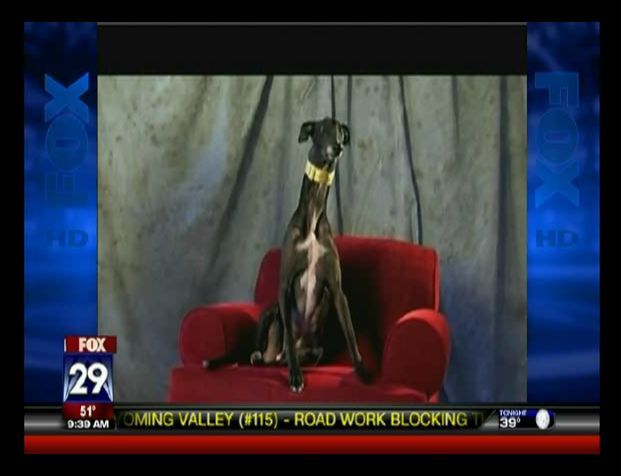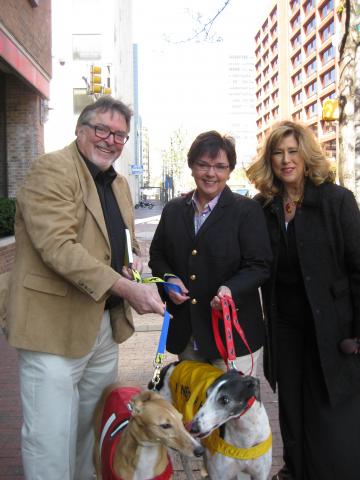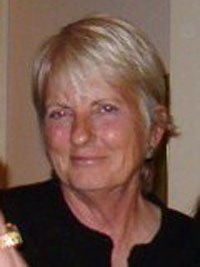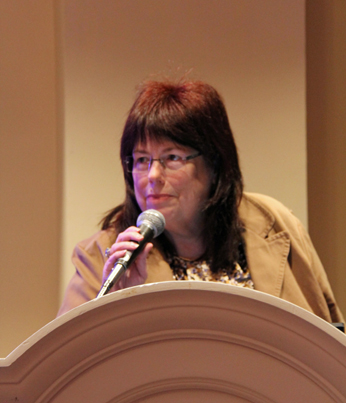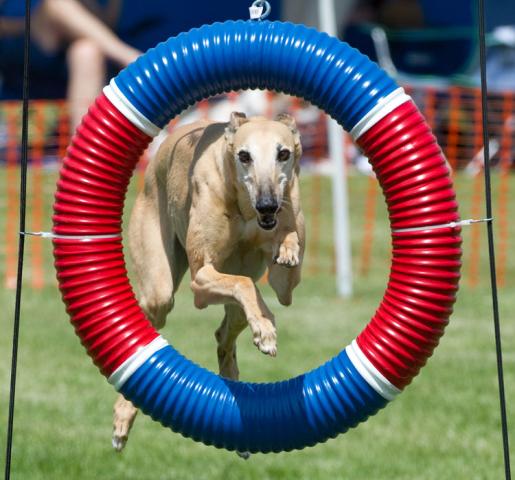Tennessee radio personality and dog advocate Karen Williams recently visted North Shore Kennels at Southland Greyhound Park in West Memphis, AR, to get an insider’s look at the life of a racing greyhound. Williams hosts the Mid-South Dogs and Cats radio show for KWAM 990 in Memphis. The show focuses on pet-related topics ranging from responsible ownership and pet care to adoption.
Responding to an invitation from veteran kennel operator and trainerJohnny O’Donnell, who had appeared as a guest on one of her shows, Williams set out to learn for herself how greyhounds are treated at the track.
The resulting column, "Dawn at the Track," touched the hearts of greyhound lovers everywhere, and has been widely circulated via social media and on various blogs. It is reprinted here with the kind permission of the author.
"Dawn at the Track"
Never having been to a Greyhound race or a racetrack gave mean edge and also a rather childish view of the events I was about to experience. I am a dog advocate, a retired Social Worker, and currently a media personality for a local radio station. I had met Mr. Johnny O’Donnell, an owner and trainer with North Shore Kennel at Southland Park Gaming and Racing in West Memphis, AR through Vicki Cohen, Director of Mid South Greyhound Adoption Option. During our interview I was impressed with his knowledge and passion for his dogs as well as his honest and patient answers to my many questions.
Like the majority of people in our communities I had heard the hushed whispers of atrocities rumored to be associated with Greyhounds in the racing industry. Many of these rumors I had dispelled due to a little common sense. It just didn’t add up that people would mistreat the very animals that supplied them with a livelihood. So when this very gracious and likable man offered to allow me to attend a morning training session to see for myself how the dogs were trained for running on the track I eagerly accepted.
On a chilly April morning I arrived at the North Shore Kennel at the customary 4:00 AM. I met with one of the few female Trainers in the US, Ms. Rhianna Marriott. She explained that the dogs were just waking up and that the kennel would be pretty loud at first until she and her assistants could get the dogs out into the yard for their morning constitutional. Since I was not familiar with their routine she suggested I stand in the kitchen area where I could watch until the dogs settled down a bit. She also told me that due to the volume it would be difficult to answer any questions until after the dogs were in the yard but that she would be more than happy to chat about them then. I nodded my understanding and stepped gingerly into my first greyhound racing kennel.
Over the last year I have been inside many kennels, those of various shelters and rescue organizations as well as individually owned breeding kennels and boarding kennels. The first thing I noticed as I entered this kennel was that it didn’t smell like a kennel and certainly not like a kennel of 78 dogs just waking up. The Kennel was comfortably warm after being out in the pre-dawn cold and there as a definitive fresh smell with a mild scent of cleaner. The sound of the dogs could only be compared to standing too close to the speakers at a rock concert. The volume was near to deafening. But I have been around dogs my entire life and recognized the barks for what they were, welcoming! Few were directed towards me. The dogs shouted good morning to Rhianna and Rachel. Their tails wagged and they stood awaiting their routine yard time.
The caretakers immediately began releasing the hounds from their crates and they yawned, barked, and stretched as they began to congregate about the door to the yard. As each one was released from their crate they were fitted with a colored muzzle. It took little time for the entire male population to be ‘turned out’ and I watched as Rhianna waded through the sea of some 50 hounds to open the door and step through. When the last male was out she closed the door so Rachel and Dylan could release the females who soon exited from a separate door. I was left there to take a moment to study the crates in sublime quite.
Each of the boxes was extra large and had a carpet placed for the dogs to lie on. Some had been pushed to their preferred area of the crate where the dog was most comfortable. Although the dogs had been crated all night I saw not one had been soiled. The crates were stacked with one on the lower section and one on the upper section. I couldn’t help but touch one. Like a child I was curious and I quickly learned they were secured somehow. Not one crate budged when I tried to move it.
Stepping back into the kitchen area I let my gaze wonder. In a large bath tub looking container was several rather large bags of what looked like hamburger thawing. Near that was a four foot stack of reputable dog food in large bags. There were shelves and a few cabinets beside the refrigerator that held vitamin bottles and other bottles I did not recognize. Across from this area I saw a large scale for weighing the dogs and boxes of dog treats. From my quick assessment I felt confident they had everything on hand to easily care for their pack.
Walking over to the door Rhianna had taken the males out I gazed outside to survey the chaos. Rhianna saw me and waved me to come on out. I walked out the door to find a small patio that lead to a large, sand covered yard where the many dogs were busy stretching, sniffing, and taking their morning potty time. Several greeted me as I moved to the gate. A few even jumped on to the fence with their front paws. Since the barking was minimal now I was able to hear Rhianna when she asked me if I would like to join the females in their yard. “There are not so many of them and you can expect to be welcomed. They may jump a bit.” I didn’t care I felt excited at the prospect of joining the 20 or so hounds who like the males were enjoying their morning yard time. I entered the opposite gate.
Once inside I was quickly surrounded by 10 or 12 of the hounds who instantly accepted me with some curiosity. A few did jump and I softly corrected them. “You’ll need to be more forceful with Becky, she’s needy.” Dylan told me. I soon learned he was right. It seemed that each dog came by in their own time and turn for a pat on the head or a scratch behind their ear. Having worked with rescued dogs for 15 plus years I realized within minutes that these dogs were confident in themselves and their caretakers. No one showed any signs of being overly timid or uncertain of my intentions as I did my utmost to pet each one who sought out my attention. These dogs are accustomed to being handled regularly by people and they have no fear of mistreatment. By the time 15 minutes had passed I was giddy with such delightful company as these wonderful hounds. Even Becky seemed to at last get her fill of pats and soon found a place in the sand to dig a shallow hole and settle down to watch the others with mild interest.
I enjoyed the scene playing out before me. Dylan talked about each of the girls. He was a wealth of information. I learned things like who usually the worse jumpers were and who liked to dig, which the jokesters were and who liked to smile at times when they were amused by us. As he talked it only reinforced what I had already seen. These dogs are working dogs, not household pets, but they are well taken care of and their caretakers know and care for them very well. These dogs are appreciated, each one, and they are very aware of that.
“Take um in.” Rhianna called and I moved out of the pen and back into the kitchen as not to get in the way. I observed this procedure as I had the letting out phase. The dogs knew where their crates were located and they came when called. Although a few had to be called twice which was not surprising with all the controlled pandemonium. Still, it was amazing to me at how quickly and efficiently the dogs were put up. We have 3 rescues at home and it takes me about the same amount of time to place them in their crates as it did for these 3 people to put 78 greyhounds in their crates.
When the last one was in Rhianna reached for a clipboard and suddenly the barking began again. This time it was a little different. The air seemed to crackle with excitement and the barks were attention oriented and demanding. I was waved behind the counter so the hallway to the outside door would be unobstructed. As Rhianna called out each name Rachael and Dylan began taking the dogs, one at a time, out the front door to the waiting trucks. 14 dogs were called in all. Each one did it’s best to drag it’s caretaker down the short hallway. Some on their back legs and others hunched low to the ground using the force from their hind quarters. I watched this with growing interest. Many of the dogs’ still who were crated barked insistently as if to complain that they were not being taken. Once loaded I was instructed to join Rachel in the truck she was driving.
“Morning training on the track,” She offered. “We have a few puppies that are still learning how the track works and where to stop. Southland Park has the largest track in the US and its oval. Very different than what they have become use to on the farm. Rhianna has chosen one that you can take out and let run but we will show you how first.”
“That sounds great!” I chirped and notice the grey hue of dawn in the sky as we pulled up to the track.
There were other trainers there with their dogs for training as well. I stood to the side and watched as two to four dogs were taken out onto the track by a handler. They carefully chose a starting point and bent over the dogs back. One hand held the collar while the other arm was bent to cradle the hound around its flank. The dogs were excited and quaked with anticipation when they heard the mechanical lure start. As I stood there I noticed several things. There was a friendly, almost jovial camaraderie among the people at the track. Everyone was pleasant and many conversations were going on around me. Most revolved around the dogs. I also noticed how every dog was just like the dogs at North Shore Kennel. Each was healthy and friendly. They were excited and struggling to get onto the track but the handlers were patient and kept them in control without raising their voices. No one spoke louder than was necessary to be heard above the occasional barking. I had been told that these dogs loved what they did and seeing how utterly excited and happy they were proved that Johnny had understated how very much these dogs lived for the chase.
As the sun began its slow assent over the horizon I watched several of the dogs race about the track. Amid the chatting and ‘sensible’ questions a notion settled over me. Within these very contemporary walls I was witnessing an ancient sport. The lovely dogs before me could have been the exact duplicates of their ancestors from a thousand years ago. Greyhounds are a very old and regal breed. There has been little refinement to the ones we see at our race tracks. The Greyhound is a true canine athlete and has centuries old instincts to guide it. As they ran I felt truly blessed to be one of the few people who have witnessed this amazing sport and feel very privileged to say that I was at least a small part in the art that is Greyhound Racing. It was as if the sun rose within me as it also rose over the track.
A pair was brought in to run. One was an older, beautiful fawn colored dog while the other was a much younger white and brindle pup. They were placed side by side and the handler held them firm as the lure began it’s coarse about the track. When it was just past them the handler’s released their hold and the dogs bolted forward. The pup was quick to take a short lead but the older dog kept pace just a half a head behind as they came into the curve of the track. The pup made to move toward the inside at the turn but the older dog saw what the pup intended and gave a short burst of speed that prohibited the pup from moving onto the rail. It also put the pup off its rhythm and the older dog won as the lure came to a squeaky halt. This may not sound like much, yet when you consider the lesson having been passed on from racer to racer, dog to dog, over the many centuries that these hounds have been running it left me feeling humbled before such gladiators.
The Sun had risen by the time Rhianna asked me if I was ready to start one of the dogs. She had chosen a small female, Enid. She was a beautiful little thing and was an experienced racer. We walked out on the track and I was patiently instructed where to stand and how to set her up and hold her. This little lady quaked with excitement and was very aware I was new but she was too focused on her job to worry with me. She was riveted to the lure and her entire body was bunched. Every muscle in her 57 pound body was taut as I leaned over her and slid my arm under her flank the way I had been shown. It is no mystery that we emit energy which pets can feel. On this brilliant morning I was reminded that we can feel their energy too. Every place her body touched my skin felt almost electrified from the excitement and the pure joy racing through her. My breath caught in my throat as her delight transferred into me.
By the time Rhianna said ‘Go’ I found myself quaking as much as Enid. I released her and she blasted forth with what I can only describe as bliss. The other handlers and Rhianna ran off the track and I could not. I was so bemused by the overwhelming feelings Enid had left me with and the urge to watch her run that I could hardly walk. I had to see her stretch out her stride and do what she was truly born to do.
With great effort I stumbled to the far right of the track to get out of the dogs way. I knew they would beat me to the end. My eyes roved over the track to see them bounding after their prey. Enid’s little body stretching out until her large chest was merely inches from the sandy ground of the track. Her eyes were locked onto the lure but she was well aware of the young hound just a few feet from her as she rounded the bend. Although I had only met this dog moments earlier there was an uncommon connection to her that left me with the overwhelming desire to shout her name with encouragement. Instead I stopped my hurry to the end and took just a few seconds to revel in the moment.
A profound sense of awe encompassed me along with the morning sun. Never had I learned so much in such a short time. Watching Enid move gracefully over the sand produced a genuine smile. She was in her element. Generations of breeding and years of good training had made her into what she was meant to be, an incredible racer. It is so very rare to know the joy and pure happiness she possessed at that very moment. And even rarer is the opportunity to share it.
As humans we are often so caught up in what we are expected to do or what we are dictated to do that we often miss out on the things we were made to do. Enid showed me that to live is about being who you are and doing what you truly love. Thank you, Enid; with your help I found my own bliss one cold ‘Dawn on the Track.’

